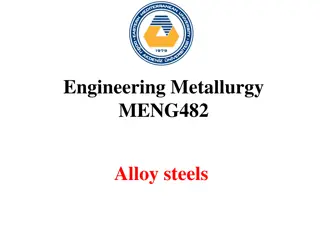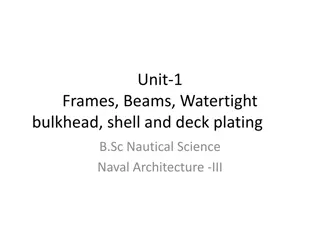Understanding Structural Steels and Designation Systems in the Industry
Structural steels play a crucial role in various industries, with specific requirements like strength, toughness, weldability, and corrosion properties. The designation and grouping systems help classify metallic materials and welding consumables according to standards set by organizations like the European Commission. Steel quality classes range from A to E based on toughness, with varying requirements for each class. The use of killed steel, with added deoxidizing agents, ensures uniform properties and prevents the formation of CO2 gas bubbles during solidification. Designation systems assign alphanumeric or numerical codes to different types of steel, with impact requirements specified for fracture toughness testing. Overall, a comprehensive understanding of structural steels and designation systems is essential for optimizing performance and safety in construction and manufacturing applications.
Download Presentation

Please find below an Image/Link to download the presentation.
The content on the website is provided AS IS for your information and personal use only. It may not be sold, licensed, or shared on other websites without obtaining consent from the author. Download presentation by click this link. If you encounter any issues during the download, it is possible that the publisher has removed the file from their server.
E N D
Presentation Transcript
Makes Industry Grow Structural steels designation, Grouping system for metallic materials and welding consumables standards Disclaimer The European Commission support for the production of this publication does not constitute endorsement of the contents which reflects the views only of the authors, and the Commission cannot be held responsible for any use which may be made of the information contained therein . 1
Structural steel Makes Industry Grow Requirements on structural steel Strength (also at high temperature) Fatigue properties Toughness Homogeneity, also in the thickness direction (Z - properties) Stiffness, Young modulus Weldability Corrosion properties Hardness, wear and abrasion resistance Dimension accuracy Surface quality General properties for steel: Specific weight (density): = 7800 kg/m3 Modulus of elasticity (Young): E = 2.1 105N/mm2 Share modulus: G = 0.8 105N/mm2 Poisson s ratio: = 0.3 Coefficient of linear expansion: = 1.2 10-5 1/ C. 2
Toughness classes for steel acc. IIW Makes Industry Grow Due to the risk for brittle fracture steel can be of different quality classes from A to E with the highest requirements in class E. A B C D E Unkilled, semi killed or killed steel semi killed or killed steel semi killed or killed steel semi killed or killed steel Killed steel Higher maximal impurity levels allowed than for higher toughness classes Limited nitrogen content 0,0009%. Limited impurities. Limited nitrogen content 0,0009%. Impact test at 0 C Limited nitrogen content 0,0009%. Impact test at -20 C. Further Limitation of impurities. Limited nitrogen content 0,0009%. Impact test at -40 C Fulfils moderate requirements and give some safety against cracks and pores in the weld metal A-steel today are in most cases better than this requirements. For welded objects of moderate thickness and normal loads were the risk for brittle fracture do not needs to be taken into consideration. For welded objects were due to thickness, loads and design a certain safety against brittle fracture are needed. Intended for welded objects where safety against brittle fracture is required. due to low application temperature, thick material,, difficult load condition and complicated design. For welded objects at low application temperature and difficult operating conditions Killed steel: A deoxidizing agent has been added to the steel to prevent CO2 gas form during solidification. A killed steel has a more uniform chemical composition and properties than other steels. Silicon is commonly used as an agent. Without agent free oxygen inside the molten steel can react with the carbon and form bubbles of CO2 gas. Depending on the amount of addetives the steel can be killed, semi-killed or unkilled. Most steel today are killed! 3
Designation system for steel Makes Industry Grow Structural steel according to EC3 Two parallel systems: Name system (alphanumerical), i.e. S355J2 according to SS-EN 10027-1. Number system (numerical), ex 1.0577 according to SS-EN 10027-2 Impact requirements (Fracture toughness) Energy levels for impact test Charpy-V notch at In Sweden the name system is used Steel type Example S P L E G Cast steel Structural steel Pressure vessel steel Steel for tube/pipe Engineering (Machine steel) E295 S355JR P265NH L360NA 27 J JR J0 J2 J3 J4 J5 J6 40 J Temp ( C) KR K0 K2 K3 K4 K5 K6 20 0 -20 -30 -40 -50 -60 GP240Gh The number after steel type indicates the minimum value for upper yield limit ReH(N/mm2) for thicknesses up to 16 mm. 4
Designation system for steel Makes Industry Grow Additional requirements A Annealed AcC Accelerated Cooling AR As Rolled C Cold formed steel CR Controlled Rolling E Tempered G1 Unkilled G2 Killed / semi killed G3 Plate: Normalized or controlled rolled Profiles: Any state of delivery if not agreed upon. G4 Any state of delivery if not agreed upon H Thermomechanical treated Ln: Low temperature M: Thermomechanical rolled N Normalized O Offshore application Q Quenched S Ship application T Tempered (QT) TM Thermomechanical rolled steel W Weather durability Notice that TM- and AcC- steel can not be warmed at temperatures above 500 to 600 C type hot straightening Quenched and tempered steel can not be heated above tempering temperature about 450 to 650 C Normalized steel can heated to around 950 C and can be hot bent and straightened 5
General structural steels Makes Industry Grow Standards for structural steel Hot rolled products of non-alloyed structural steels (Carbon-manganese steel) Suitable for welding. Used in buildings, machines, vehicles. Example: SS-EN 10025-2-S275J2, S355J2 (1.0577) Hot rolled products of weldable fine grain steels (Normalized fine grain steel) Good weldability and high strength. Used frequently in buildings. Can be normalized after delivery without losing strength. Example: SS-EN 10025-3-S355NL (L: 27J/-50 C, without L: 40J/-20 C) Hot rolled products of weldable fine grain steels (thermometrical rolled steel) Lower carbon equivalent than the normalized steel. Gives better weldability. Loses its strength above temperatures more than 580 C. Example: SS-EN 10025-4-S355ML Structural steel with improved atmospheric corrosion resistance Example: SS-EN 10025-5-S355J2W High yield strength structural steels in the quenched and tempered condition To be used when higher demand for strength than micro alloyed steels can meet. Example: SS-EN 10025-6-S690QL (L: 30J/-40 C, L1: 30J/-60 C, without L: 30J/-20 C) 6
General structural steels Makes Industry Grow Standards for structural steel Thermomechanical rolled steel for cold forming The steels are used in transport industry due to their bendability. Will loose strength if the temperature is higher than 580 C. Lower carbon equivalent than the normalized steels 10149-3. Example: EN 10149-2-S420MC (M: Thermomechanical rolled. C: steel for cold forming) Normalized steel for cold forming The same bendability, lower yield strength and higher carbon equivalent (less weldability) than the Thermomechanical rolled steels but can be normalized without affecting the strength Example: SS-EN 10149-3-S420NC Hot finished structural hollow sections of non-alloy and fine grain steels Example: SS-EN 10210-1-S355J2H Cold formed welded structural hollow sections of non-alloy and fine grain steels Example: SS-EN 10219-2-S355J2H Alloyed steels, like stainless steels. Example: SS-EN 10088 1.4301 (X5CrNi18-10) / 1.4462 (X2CrNiMoN22-5-3) Duplex 2205 7
SIS-CEN ISO/TR 15608 Metallic materials grouping system Makes Industry Grow Welding Guidelines for a metallic materials grouping system Group 1.1 1.2 1.3 1.4 2 3 4 5 6 7 8 9.1 9.2 9.3 10 11 21-26 31-38 41-48 51-54 61-62 71-76 Type of material CMn-steel with a yield strength , ReH 275 N/mm2 Steel with a yield strength 275 < ReH 360 Normalized steels yield strength ReH> 360 N/mm2 Steels with improved atmospheric corrosion resistance Thermomechanically treated fine-grain steels and cast steels, ReH> 360 N/mm2 Quenched and tempered and precipitation-hardened fine-grain steels, ReH> 360 N/mm2 Low vanadium alloyed Cr-Mo-(Ni) Cr-Mo steels free of vanadium with C 0.35% High vanadium alloyed Cr-Mo-(Ni) steels Ferritic, martensitic or precipitation-hardened stainless steels 10,5%<Cr<30% Austenitic stainless steels, Ni 31% Nickel alloyed steels Ni 3% Nickel alloyed steels 3% < Ni 8% Nickel alloyed steels 8% < Ni 10% Austenitic ferritic stainless steels (duplex Steels covered by group 1 except 0,25% < C 0,85% Aluminium och aluminium alloys Copper och copper alloys Nickel and nickel alloys Titanium och titanium alloys Zirconium och zirconium alloys Cast iron 8
SS-EN 10204-3.1 Inspection Certificate for steel Makes Industry Grow Inspection certificate EN 10204-3.1: The supplier certifies that the goods comply with the order and states test results, the document is validated by an independent authorized inspector. 9
EN-Standards for consumables Makes Industry Grow Method 111 MMA 131, 135 MIG/MAG 141 TIG 121, 122 SAW 114, 136, 138 MAG 131 Gas welding Consumable covered electrode Solid wire Solid wire/rod Wire/band Flux Tube electrode Solid wire Non alloyed & fine grain steels 2560 14341 636 14171 14174 17632 12537 High strength steels 18275 16834 16834 26304 14174 18276 - (ISO missing) Creep-resisting steels 3580 21952 21952 24595 14174 17634 Stainless & Heat resistant steel 3581 14343 14343 14343 14174 17633 - Nickel & nickel- alloys 14172 18274 18274 18274 14174 12153 - Cupper & cupper alloys - 24373 - - - - 24373 Aluminium - 18273 - - - - 18273 Cast grey iron 1071 1071 1071 - - Titanium - 24034 24034 - - - - 10
Covered and cored electrodes Example Makes Industry Grow Covered electrodes, MMA Flux cored tubular wire electrodes, MIG/MAG Method 111: OK 55.00 E 46 5 B 12 H5 Method 136: OK Tubrod 15.15: T 46 2 P C 1 H5 / T 46 2 P M 2 H5 11
Consumables for non alloyed & fine grain steels Makes Industry Grow SS-EN ISO 17632: T 46 2 P C 1 H5 SS-EN ISO 17632: T 46 2 P M 2 H5 SS-EN ISO2560: E 46 5 B 12 H5 12























